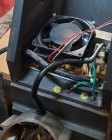Greetings,
I'm in a constant battle of resetting a tripped breaker if I dig just a slightly too hard on a cut. As a result, I find myself taking probably 5x longer to turn a piece than I should.
I use a meager Craftsman Model 351 Variable Speed lathe. The motor is 2HP, 90v, 12Amp, Single Phase.
And its running on it's own 20amp brand new Square D breaker with a 20amp GCFI using 12awg wire. Nothing else is connected to that line. Typically, it's the breaker that trips and occasionally it will be the GCFI.
I'm no electrician and my knowledge is pretty limited in that regards. But else might I try here? Would it be worthwhile to replace that GCFI with a standard "heavy duty" 20amp outlet? Or maybe there is a different type of breaker I should consider?
I appreciate any suggestions. Thanks!
Rick H.
I'm in a constant battle of resetting a tripped breaker if I dig just a slightly too hard on a cut. As a result, I find myself taking probably 5x longer to turn a piece than I should.
I use a meager Craftsman Model 351 Variable Speed lathe. The motor is 2HP, 90v, 12Amp, Single Phase.
And its running on it's own 20amp brand new Square D breaker with a 20amp GCFI using 12awg wire. Nothing else is connected to that line. Typically, it's the breaker that trips and occasionally it will be the GCFI.
I'm no electrician and my knowledge is pretty limited in that regards. But else might I try here? Would it be worthwhile to replace that GCFI with a standard "heavy duty" 20amp outlet? Or maybe there is a different type of breaker I should consider?
I appreciate any suggestions. Thanks!
Rick H.




